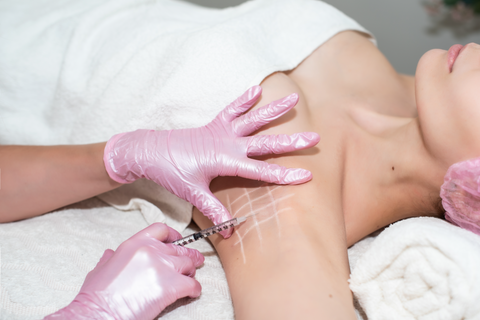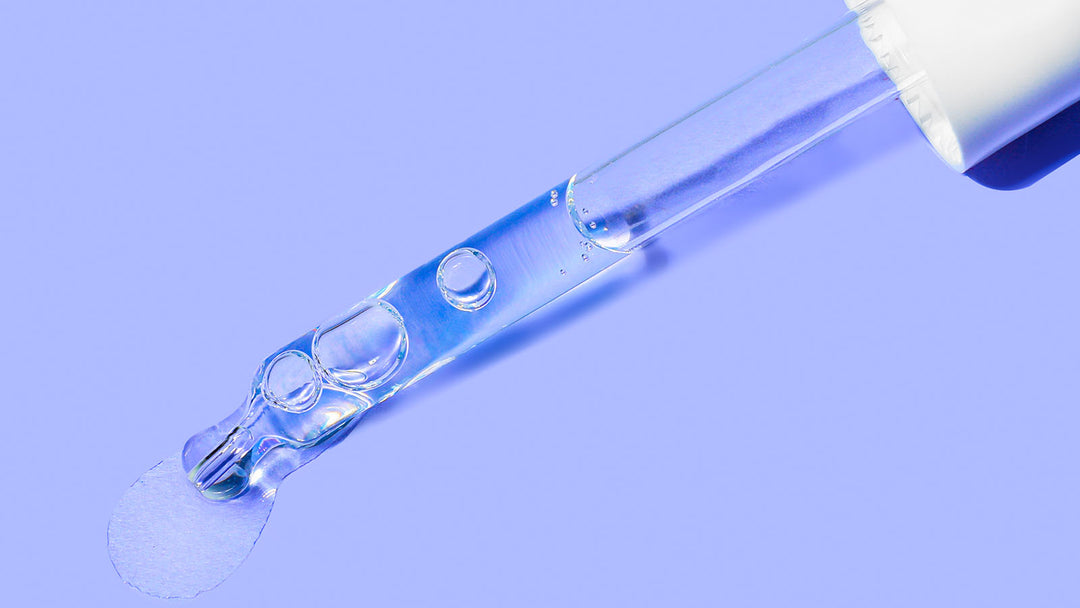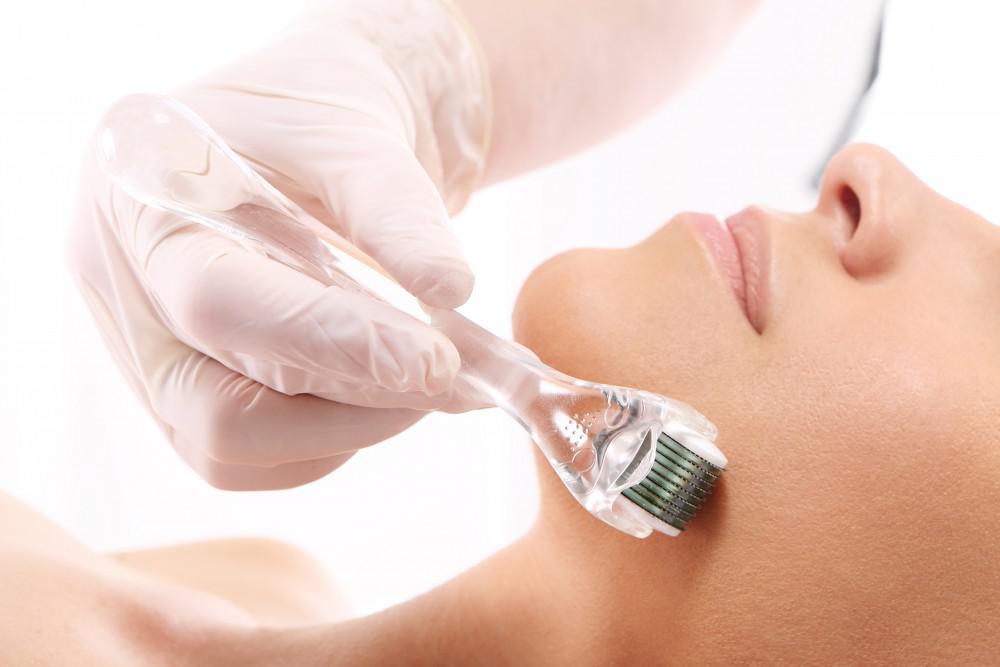Botox for Hyperhidrosis
Nervous about a job interview? Holding a plank position in a hot yoga class? In hot and stressful situations, sweating is normal. Your underarms become sticky and moist and all of a sudden, you feel like you’re sweating buckets. However, if your underarms sweat without reason, and neither over-the-counter or prescription antiperspirants are helping, you might want to consider Botox injections for hyperhidrosis.
What Is Hyperhidrosis?

Hyperhidrosis is characterized by excessive sweating over what is needed to maintain body temperature. Approximately 1.3 million Americans suffer from severe hyperhidrosis which might lead to decreased physical and emotional well-being, difficulties in personal relationships, and social stigma.
Surgery and nonsurgical treatment options are available for treating primary hyperhidrosis. In addition to being short-acting and often requiring frequent reapplication, topical antiperspirants like aluminum chloride are ineffective at reducing sweat production and are intolerable due to irritant dermatitis, which is often the most common nonsurgical treatment. Endoscopic transthoracic sympathectomy (ETS), arthroscopic shaving, and sweat gland excision are some of the most common surgical procedures.
Anesthesia, operative fees, and time for recuperation are required for these invasive treatments, which may result in serious complications and recurrence rates. As a result, the ideal treatment would be less invasive and safer than surgery, as well as longer-lasting and more tolerable than topical agents.
These criteria have made botulinum toxin type A a viable treatment option for patients suffering from focal hyperhidrosis. By inhibiting acetylcholine release, the toxin prevents excessive sweating caused by overstimulated eccrine sweat glands.
In healthy patients, injection of the toxin had been observed to inhibit sweat production, prompting researchers to suggest its potential benefits for patients with hyperhidrosis. Botulinum toxin type A has been shown to be a safe, effective, and long-term treatment for primary hyperhidrosis in several studies.
Researchers have shown that patients who are unresponsive to topical antiperspirants who receive botulinum toxin experience 75% reduction in sweating, improvement in emotional and physical well-being, and a decrease in activity limitations when injected with botulinum toxin. Practice has shown that symptoms reduce within two weeks of treatment.
What Causes Excessive Sweating?
Sweating excessively can be caused by a variety of factors, with genetics being one of the most common causes. Other causes may include hypothyroidism, diabetes, or neurological disorders such as Parkinson's.
There are two main types of hyperhidrosis:
- Primary hyperhidrosis is caused by genetics and affects 30-50% of the population. There is no known cause for the majority of these patients.
- Secondary hyperhidrosis may also result from an underlying health problem. A number of diseases can cause excessive sweating, including hyperthyroidism, obesity, adrenal gland disorders, and Parkinson's.
Hyperhidrosis can be treated with Botox. In the case of secondary hyperhidrosis, the best treatment is to treat the underlying cause, which normally reduces excessive sweating; however, Botox can be used if this is not possible.
It is recommended that you first seek advice from your GP if you have new hyperhidrosis so that secondary hyperhidrosis can be ruled out.
What Is Botox?

Botulinum neurotoxin is made from a microbe that causes botulism (a type of food poisoning). But don't worry, if used correctly by a medical professional, it's very safe.
In cosmetic treatments, Botox is most often used to temporarily paralyze muscles to smooth facial wrinkles. Botox is also used to treat neuromuscular conditions such as migraines, muscle spasms, and hyperhidrosis.
If prescription antiperspirants do not improve your sweating, you may be a candidate for Botox. FDA-approved Botox is used to treat excessive sweating from the armpits. In addition to reducing sweating in the face, hands, and feet, it can also reduce sweating in other parts of the body.
How Does Botox Treat Sweating?
When you receive Botox injections, the neurotransmitter acetylcholine is blocked, which stimulates sweat glands to release fluid. Normally, your sweat glands are activated when the temperature of your body rises. In this way, your body naturally cools itself. People with hyperhidrosis, however, have overactive sweat gland nerves.
When Botox injections are administered directly to the sweating areas of your body, your overactive nerves become paralyzed. If your nerves cannot communicate with your sweat glands, you can't sweat. A Botox injection, however, only prevents sweating around the injection site.
Where Can Be Botox Used to Treat Sweating?
Currently, underarm sweating is the only condition for which Botox is approved. Different studies have found varying results, but Botox has been shown to reduce armpit sweat production by over 50 percent for at least six months.
Other areas of the body are treated with it "off-label".
- Palms - There has been limited research on Botox's effectiveness in treating palm sweating. According to some studies, Botox can reduce sweating by 25 to 50 percent for 3 to 6 months.
- Face - Research has found that Botox may help treat facial sweating, but the research is very limited. With Botox, facial sweating could be reduced for up to 6 months, causing paralysis in the forehead muscles.
- Soles of the feet - Few studies have been conducted on Botox's ability to control foot sweating. One small study conducted in 2018 found that 73 percent of participants between the ages of 12 and 17 were satisfied with the results.
How to Prepare for the Procedure?

Botox injections can be done easily and quickly in your doctor's office. Before your appointment, most doctors ask you to wear a short-sleeved shirt and avoid shaving your armpits for two or three days. In order to prevent bruising, your doctor may ask you to stop taking blood thinners for a few days before your injections. If you are taking medications, let your doctor know, and don't stop taking them unless your doctor says so. To avoid getting ink on your shirt, your doctor might also suggest wearing dark-colored clothes.
After the Treatment
Almost all Botox patients are able to leave the clinic immediately following the procedure. For the rest of the day, they should avoid exercise and hot baths and showers.
Most healthcare providers recommend a follow-up appointment one to two weeks after the procedure. During this step, any missed areas will be touched up, and side effects will be checked.
It is often recommended that you avoid using deodorant or perfume under your arms for about 12 to 24 hours in order to avoid irritation. It may also help to avoid intense exercise and hot baths for one or two days.
Possible Side Effects
In general, Botox injections are safe. Although serious side effects are rare, they can occur. These include:
- muscle weakness or asymmetry
- a severe allergic reaction
- toxicity
If you've had any of the following side effects after Botox injections, you should immediately seek medical attention:
- having a hard time breathing, swallowing, or speaking
- skin rash or hives
- muscle weakness
- vision problems
- dizziness
- loss of bladder control
These are some of the less severe side effects:
- dry mouth
- headache
- fatigue
- pain in the underarms after the injections
Advantages and Disadvantages of Using Botox for Hyperhidrosis
As with any treatment for excessive sweating, Botox has a number of pros and cons. Below are some examples of each.
Pros:
- highly effective
- long-lasting
- almost painless
- non-invasive
Cons:
- expensive
- not permanent
- has some side effects
- can not be used on all areas of the body
Those experiencing excessive sweating should talk to their doctor about the best treatment options for their condition.
Other Uses of Botox

There are a number of other potential uses for Botox, including:
- Muscle disorders: By controlling excessive muscle movements, such as muscle twitches, Botox can relax clenched muscles.
- Chronic migraine: Some people may benefit from Botox for chronic migraine prevention.
- Facial wrinkles: Dermatologists may inject Botox into the face to reduce the appearance of wrinkles and fine lines.
How Does It Feel When Getting Botox Injections?
A typical appointment lasts about 45 minutes, but injections only take about 20 to 30 minutes. It is best to have Botox injections administered by a trained professional. A short office visit is all that is required to perform the injection.
Using a fine needle, a professional will mark your skin with ink and inject Botox medication just beneath the surface. You'll receive 15 to 20 injections around the area of concern in a grid pattern. Depending on the clinic, you may receive a slightly higher amount. If you are experiencing pain, the practitioner may give you something to ease it, such as ice or numbing agents.
Once your Botox injections are complete, you can resume your normal activities. It is likely that the practitioner will request a follow-up appointment to touch up any areas where they missed applying the injections.
When Can You See Results from Botox for Hyperhidrosis?
After receiving Botox injections, you can resume your normal activities immediately. You should notice results within 2 to 4 days and the injections should take full effect within 2 weeks.
Since Botox injections have temporary effects, you will need more in the future. It is usually necessary to administer booster injections every seven to sixteen months to treat underarm sweating. You may need to repeat your treatment after about 6 months for the hands and feet. In spite of this, Botox's effectiveness for these parts of the body is still limited.
Where to Safely Get Botox for Hyperhidrosis?
Wondering where to get this highly popular treatment done? Try typing ‘Botox for hyperhidrosis near me’ - a host of options should pop-up on the first page of Google. When making your pick, always make sure that the person administering the Botox injections is a board-certified dermatologist.
Look for a professional who has already used Botox for excessive sweating successfully. You should choose someone who is familiar with the treatment and the potential side effects that you might experience afterwards.
What’s more, a qualified dermatologist will know who is not a suitable candidate for Botox. For example, people taking certain medications or people dealing with conditions such as myasthenia gravis usually aren’t good candidates for this procedure.
What’s the Cost of Botox for Hyperhidrosis?
There are numerous factors that can affect the price of Botox injections, including where you live, the clinic where you go, and your circumstances. You can expect large costs if you need work done on several areas of your body. It costs about $1,000 to have both underarms done.
Depending on the insurance company, hyperhidrosis treatment may be covered in full or in part. Most insurance companies require you to try other options, such as prescription antiperspirants, before covering this.
The Bottom Line
The use of Botox can be an effective treatment for excessive sweating. It can significantly improve the quality of life for some people. Although the injections can be expensive and aren't always covered by insurance, they may be a good option if other treatments like prescription antiperspirants don't work. It may be possible to get your Botox injections covered by your insurance company or doctor.




